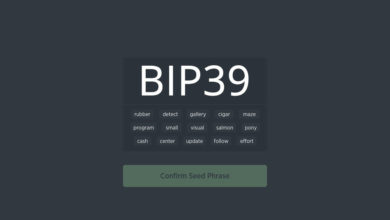Stellite Cash (XTL) – What is Stellite? Beginners guide to Stellite wallet
We’ve only published a few articles covering about CryptoNote coins and the last one was about IPBC. Cryptocurrencies that are based on CryptoNote technology are open source, decentralized and have 3 things in common. They are secure, untraceable and they are completely privacy focused. With the help of CryptoNote anyone can launch a coin and there are several crypto currencies based on this technology. Most of them are just a clone with no new features however this particular coin; Stellite Cash is an exception. Here in this article we’ll see What is Stellite Cash and what makes Stellite project unique. Once we cover that we’ll proceed to Stellite wallet guide that explains how to setup and use both CLI and GUI wallet.
What is Stellite Cash (XTL) ?
Stellite Cash, Stellite Coin or Stellite Cryptocurrency is a open source modern, fully decentralized and private cryptocurrency. Stellite is based on CryptoNote technology that uses CryptoNight hashing algorithm. It is a soft fork of Monero (XMR) and Electroneum (ETN) – Two of the most popular privacy CryptoNote coins. Stellite has this three main features such as security, privacy and untraceability.

With Stellite, none of your transactions are reveled on the blockchain. By default all your purchases, transfers and receipts remain private. It uses distributed peer-to-peer consensus network which makes the transaction cryptographically secured. Also Stellite uses ring signatures which makes your transactions untraceable. While these are common aspects which can be seen on most of the crypto currencies what new does Stellite offers?
What makes Stellite unique?
There are 2 unique features Stellite mentions. 1. Peer to Peer decentralized node list via IPFS and ZeroNet and 2. True Mobile mining (Yes, you heard it right, mobile mining). Both of this features are on road map and yet to implement. While mobile mining was already introduced by Electroneum this IPFS and ZeroNet integration is new. Stellite is the first crypto currency to link IPFS and ZeroNet with blockchain. What are they and what benefits do they provide?
IPFS: IPFS stands for Interplanetary File System; is a protocol and a network designed to create content addressable. It is a decentralized method of sharing and storing media in a distributed file system just like Bit Torrent.
ZeroNet: ZeroNet is a decentralized web-like network of peer-to-peer users. While IPFS permanently stores the files and node list; ZeroNet acts as a frontend to access the storage.
With both this feature integrated Stellite becomes completely decentralized and free from security risks. More info on this feature can be found on the Whitepaper.
True mining on all device:
It is well known that CryptoNight (new V7) algorithm is ASIC resistant and can be mineable using both CPU and GPU. However mining using Mobile Phone is a new idea. Stellite is working on to bring mining on all sorts of devices from Smart TVs to Smart Phones. They are going to implement this with a custom miner which ensures there won’t be any damage to the hardware. They promise that it is not a simulation, but instead a true mining system in which a person can create an address and start mining from any device. Alright, let’s see Stellite technical specifications and get straight in to wallet setup guide.
Stellite Coin specifications
Stellite was announced on late Jan 2018. It’s already been listed on coin market cap and available for trading at 2 exchanges. Current the price of XTL is 16 Satoshi ($0.0015) with a market cap of 3.61 million USD.
Ticker: XTL
Total Supply: 21 Billion XTL coins
PoW algorithm: CryptoNight V7
Block Rewards: (MoneySupply – A) >> 18
Difficulty adjustment: Every Block
Genesis block: 2018-01-22
Pre-mine: 0.6%
Stellite Wallet
Stellite offers both CLI (Command Line Interface) and GUI (Graphical User Interface) wallets. They are available for Windows, Mac as well as Linux. Stellite has also been added to the Cheddur app – A mobile wallet that’s available for both IOS and Android. It is recommended that you download and setup the official CLI or GUI wallet. Here we’ll show you how to setup and use both CLI and GUI wallets. Previously their GUI wallet was based on SumoKoin wallet, but now they’ve released a new version with unique design.

If you’d like to grab a quick wallet then you can generate a paper wallet from here which you can later import it to GUI or CLI wallet. It is similar to Monero paper wallet; that is upon generating it gives you the keys and seed words. Make sure to store your Mnemonic seed which is all you need to keep your funds safe. If you lose it you lose access to all of your funds.
Stellite GUI wallet setup
If you are looking for an easy to use wallet and don’t like to input commands then we recommend you to download and run the GUI wallet. It is similar to QT wallet.
1. Go to Stellite GUI wallet GitHub release page and download the latest version which is StelliteGUI v0.0.8-1 ‘Carbon V2’ (at the time of writing this article).
2. Once downloaded, unzip the wallet and open stellite-wallet-gui.exe file
3. Choose your language and on next screen you’ll be provided with 3 options. Create a new wallet, restore from keys and open a wallet from file.
Import Paper Wallet: If you have the paper wallet generated already then click on “Restore wallet from keys or Mnemonic seed”. Enter your seed and proceed to the next screen where you’ll be asked to enter your password. Enter a strong password and proceed to next screen. That’s it! Your wallet is imported and now ready. Once the blockchain is synchronized you should see all transactions.
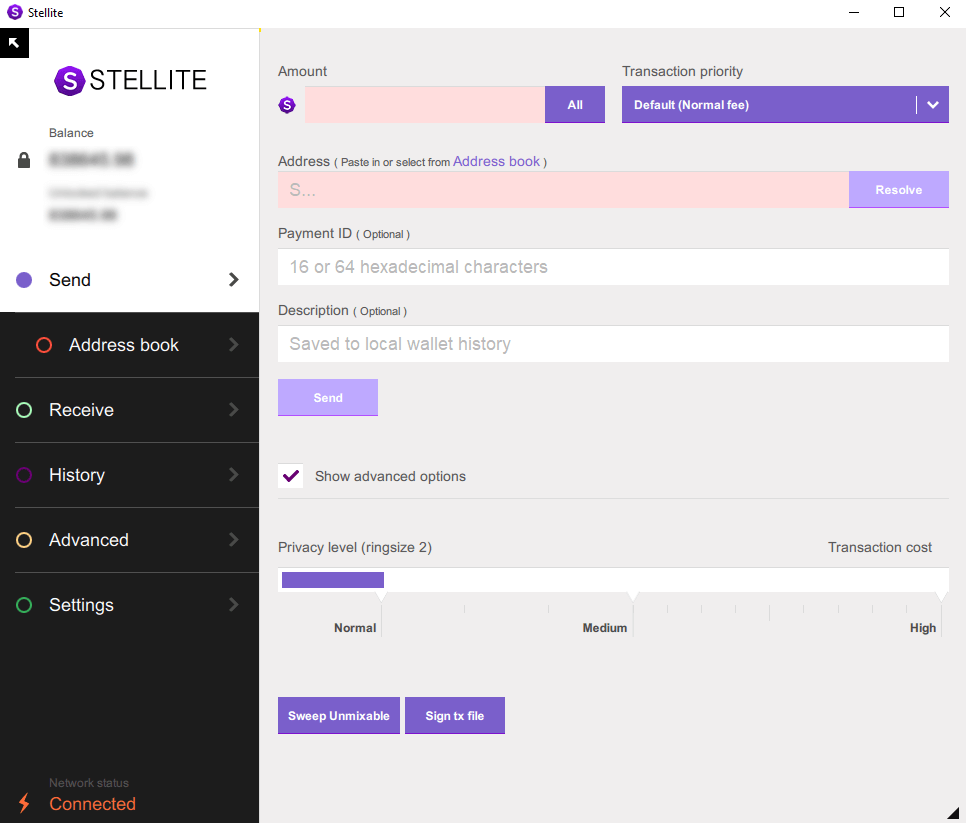
New Wallet: To create a new wallet just proceed with “create new wallet” option. Make sure to save the Mnemonic seed which the wallet generates for you on the next screen. Proceed further, set a strong password and you’re all setup!
Setting up GUI wallet is quite simple and the wallet is self explanatory. If you go to Advanced tab you should see wallet mining option. Just set the CPU core and start mining right away. Also you’ll find Sign / Verify message which is a common feature that can be found on most cryptocurrency wallets.
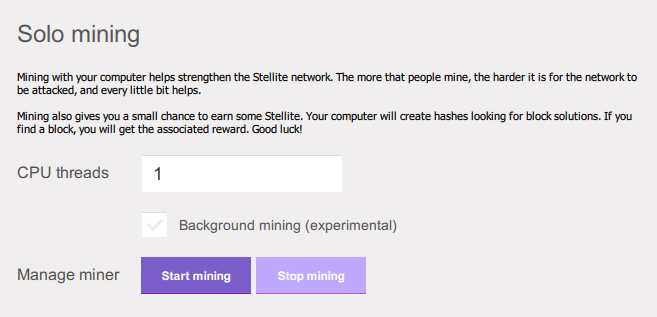
Note: Since there is a inbuilt miner in wallet your Antivirus may block the wallet. Just add exclusions to the wallet directory and it will connect to the blockchain.
By default Stellite puts all core date in main directory that is:
Linux: /root/.stellite
Mac: /Users/(username)/.stellite
Windows: c:\programdata\stellite
Stellite CLI wallet guide
Now let’s see how to create a new Stellite address using CLI (Command Line Interface) wallet.
1. Go to Stellite GitHub release page and download the latest CLI wallet version which is Stellite v1.2.3.2 ‘Carbon v2’.
2. Now unzip the file, open bin folder and start stellited.exe. It will open a command window and start downloading the blockchain. The daemon will start synchronizing with the network and this may take a long time to complete. Leave the window open and move on to next step.
3. In same bin folder now run stellite-wallet-cli.exe which will open another command window.
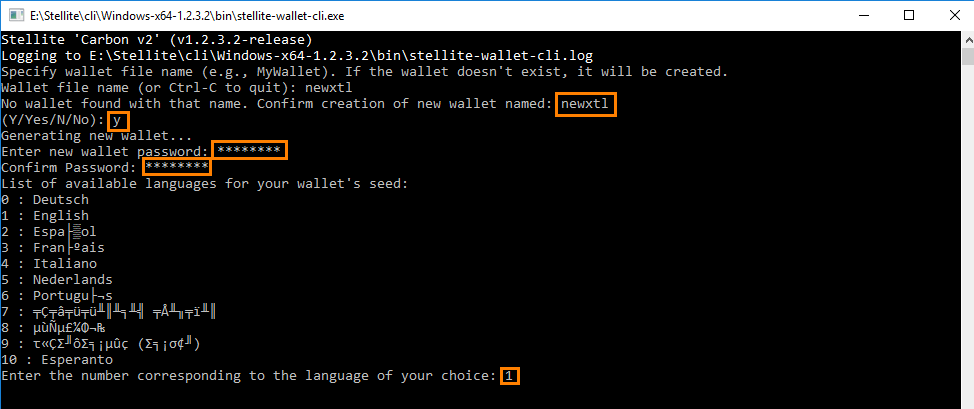
4. Just follow the on screen instructions to create a new wallet. Set a new name to your wallet and hit enter. Input Y and hit enter to confirm creation of new wallet. Then enter a strong password, select language and hit enter.
5. Now it will generate a new wallet address, view key and a 24 words recover access to your wallet (seed word). Your wallet is ready! Copy all those information and store it in a text file. The generated public address is what you’ll need to start mining or to receive and store XTL.
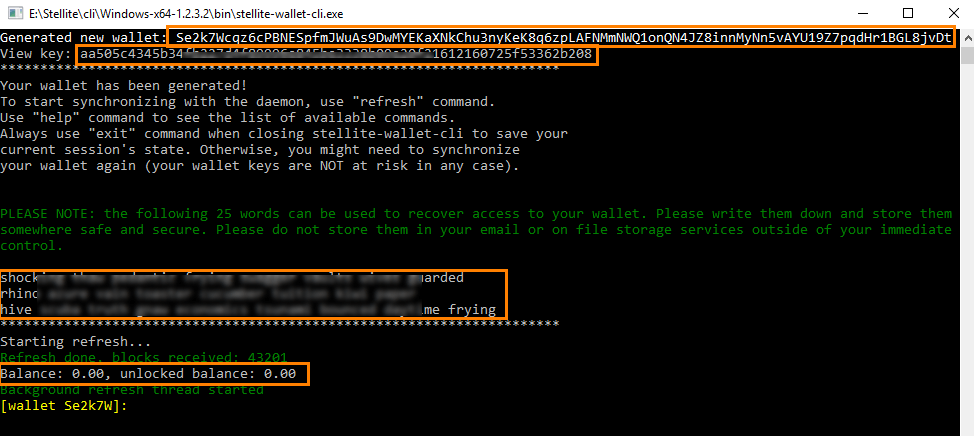
Pro Tip: Just type help and enter. It will provide you with the list of commands and their functions.
Importing paper wallet to CLI or switching from GUI to CLI:
Let’s say you wish to switch from GUI to CLI wallet or you are looking to import paper wallet to CLI. This is how you do it. First make sure stellited.exe is running in the background.
In Windows: Open CLI wallet folder >> bin and then create a new text file. Now rename it as start.bat (Windows batch file) and input the following line and save it.
stellite-wallet-cli.exe --restore-deterministic-wallet
Now run start.bat which will open a command window. It will now ask for a wallet name, you can name any as you wish. Once done enter wallet Mnemonic seed and hit enter, now set a strong password for your wallet and hit enter again. It will then start loading all your transaction associated with the address.
In Linux: Start the daemon first. Then open a new terminal and type in the following command.
./stellite-wallet-cli --restore-deterministic-wallet
Input your wallet seed and Voila! Your wallet is ready and it will show your balance.
Stellite wallet error and troubleshooting:
Often people have trouble with Stellite wallet and some of the common known errors are as follows:
- GUI or CLI wallet not updating blocks.
- Transaction taking too much time to confirm in the network.
- Losing wallet password and recovering using mnemonic seed.
- Wallet showing 0 balance even though the daemon is fully synced.
- Sweeping address, can’t send coins, no connection to the daemon, wallet not opening or taking too much time to synchronize and much more.
All these known issues have been explained here which you can refer if you go through any such trouble with the wallet. Hope that helps.
Conclusion:
Stellite is a new privacy Cryptocurrency that is competing with Electroneum. It is new, the team is young, strong, active and the community is growing gradually. We don’t know if it will really redistribute wealth using Blockchain however the idea that it carries seems promising. Also in one of their tweets they mentioned that they are going to introduce Stellite Pay – A platform like PayPal for Crypto. Sounds interesting right?
Aside from all that please bear in mind that this is just a wallet tutorial which explaining the coin aspects. It is not any sort of advise so before mining or investing kindly do your own research. If you found this guide helpful then please do share it. What do you think about Stellite? Is it worth it? Do share your comments.



